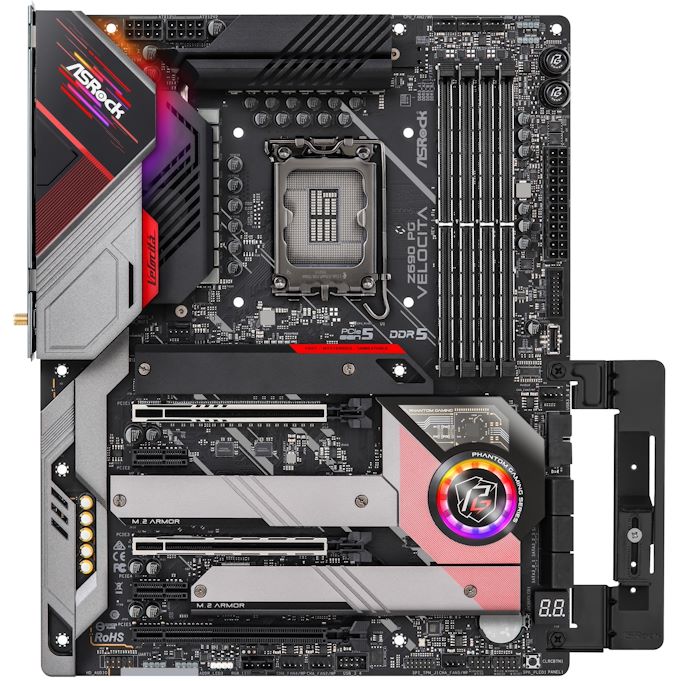The Intel Z690 Motherboard Overview (DDR5): Over 50+ New Models
by Gavin Bonshor on November 9, 2021 9:00 AM ESTASRock Z690 PG Velocita (DDR5)
Sitting below the Z690 Taichi in its product stack, ASRock also has a couple of Phantom Gaming series branded boards for Intel's Z690 and Alder Lake launch. The most apparent of the ATX sized versions is the ASRock Z690 PG Velocita, which was introduced back during the launch of Intel's 10th generation Z490 chipset. The ASRock Z690 PG Velocita has an interesting design layout, with elements of black, red, and purple within the rear panel cover, and integrated RGB LEDs built into both the rear panel cover and chipset heatsink.
Looking at the board's PCIe slot support. ASRock includes five PCIe slots in total, including one full-length PCIe 5.0 x16, one full-length PCIe 4.0 x4, one full-length PCIe 3.0 x4 slot, and two PCIe 3.0 x1 slots. For storage, there are four M.2 slots in total including one with support for PCIe 5.0 x4 drives when they eventually hit the market, two PCIe 4.0 x4 M.2 slots, and one PCIe 3.0 x4 M.2 slot. ASRock also includes six SATA ports with support for RAID 0, 1, 5, and 10 arrays. Located in the top right-hand corner are four memory slots, which can support speeds of up to DDR5-6400, and a combined capacity of up to 128 GB.
On the rear panel of the ASRock Z690 PG Velocita is one USB 3.2 G2 Type-C, one USB 3.2 G2 Type-A, six USB 3.2 G1 Type-A, and two USB 2.0 ports. There's a pair of video outputs consisting of an HDMI and DisplayPort, while five 3.5 mm audio jacks and S/PDIF optical output are powered by a Realtek ALC1220 HD audio codec. The board includes two RJ45 ports, with one powered by a Killer E3100G 2.5 GbE controller, and the other by an Intel I219-V Gigabit controller, with wireless support coming from a Killer AX1675 Wi-Fi 6E CNVi. Finishing off the rear panel is a small BIOS Flashback button.












126 Comments
View All Comments
GeoffreyA - Saturday, November 13, 2021 - link
Certainly, there are tradeoffs, keeping a socket; but, as Mr. Tuvok would say, "Ryzen, you are an unending source of astonishment." There was a time when sockets even took CPUs from different manufacturers. I remember my Socket 7 motherboard, though I never tried it, could take a K5 and some Cyrix CPUs as well. Those 5x something, something. How things have changed.A short-lived socket can be a pain in the behind too. I was one of those unlucky folk who ended up with Socket 754 and missed out on dual-channel DDR and a long upgrade path. In any case, that computer went kaput after four years.
Oxford Guy - Wednesday, November 10, 2021 - link
Overclocking is for employees of motherboard companies.ECC RAM support should have been a standard feature from the beginning. Apple offered it on the Lisa in ‘83 and consumer computing has gone backward since.
Doublers, though... aren’t a bad thing as long as they’re implemented well — as I understand it. Better to have a good doubler implementation than a weak individual phase system. The main thing is to have a board meet the minimum spec for reliable (i.e. not overheating and/or failing) long-term support of its supported CPUs. Anything beyond that is unnecessary.
GeoffreyA - Saturday, November 13, 2021 - link
The problem with doublers is, they over-use it as a marketing technique to give the impression that a certain board has a large amount of phases.Oxford Guy - Saturday, November 13, 2021 - link
Weak phases with a mediocre/poor regulator aren’t necessarily better than ‘marketing phases’ via the use of doublers. That’s the case when the doublers are used a correctly.There are a lot of shenanigans, though — like not even utilizing the doubler fully but counting it as the doubling of phases. I also recall that one of the big tricks was putting extra chokes on the board to make it look like there are more phases.
GeoffreyA - Sunday, November 14, 2021 - link
Quite right, and one of the reasons why people have got to read a proper analysis of the VRM, or take a look at the lists on hardwareluxx for example.t.s - Tuesday, November 9, 2021 - link
Wish Intel go with their atv12vo. Or like business lines from HP, Dell, Lenovo, etc. 6 or 8 pin.shabby - Tuesday, November 9, 2021 - link
Mobo prices will go up even more, screw that.meacupla - Tuesday, November 9, 2021 - link
In the long term, I think the cost for ATX12VO will be cheaper.ATX12VO PSU will be cheaper than a comparable quality ATX PSU.
The BoM for 12V to 5V and 12V to 3.3V converters would go down, if mobo makers decide to stick to a single, standardized design.
With the way things are looking, electricity prices are unlikely to go down and continue to go up.
DigitalFreak - Tuesday, November 9, 2021 - link
All ATX12VO is doing is shifting the cost from the PSU to the motherboard.Wrs - Wednesday, November 10, 2021 - link
If mobo makers can stick to one design why can't PSU makers? They already conform to ATX.ATX 12 VO increases costs for piecemeal upgraders because of the simple observation that PSUs outlive motherboards. The question would be whether the power savings are worth it. For prebuilts they're comparing power savings to 0 net component cost so 12VO is already the norm.